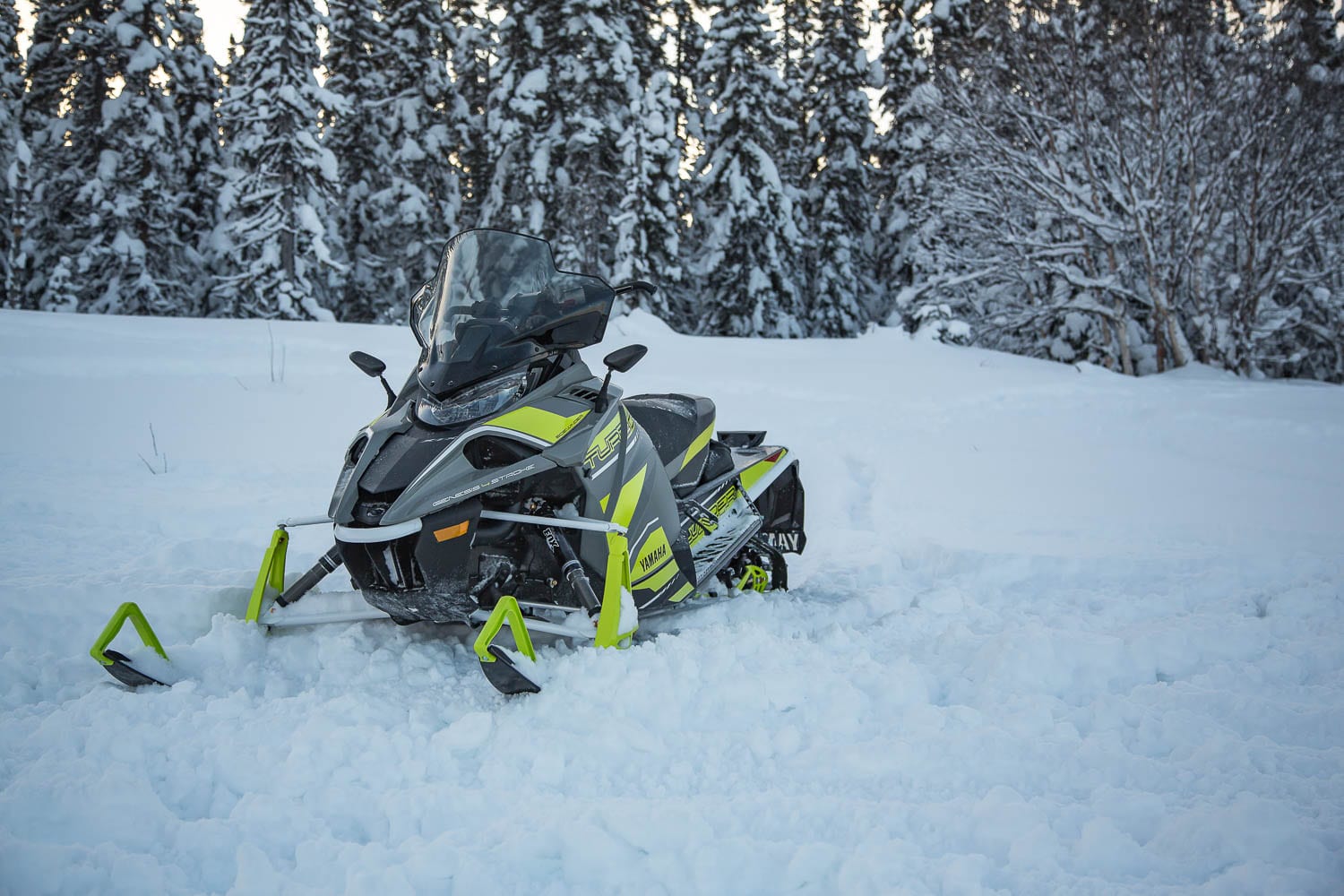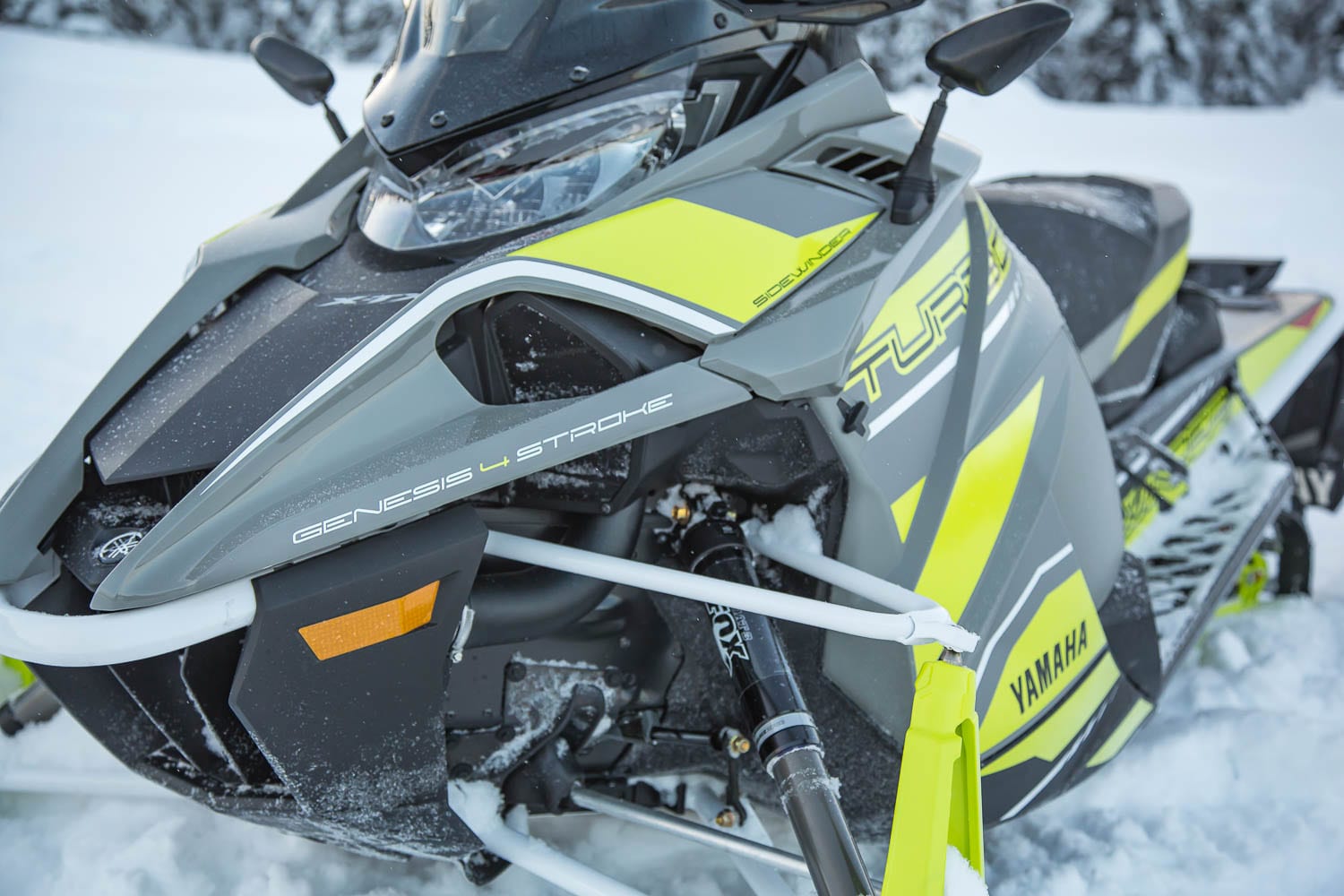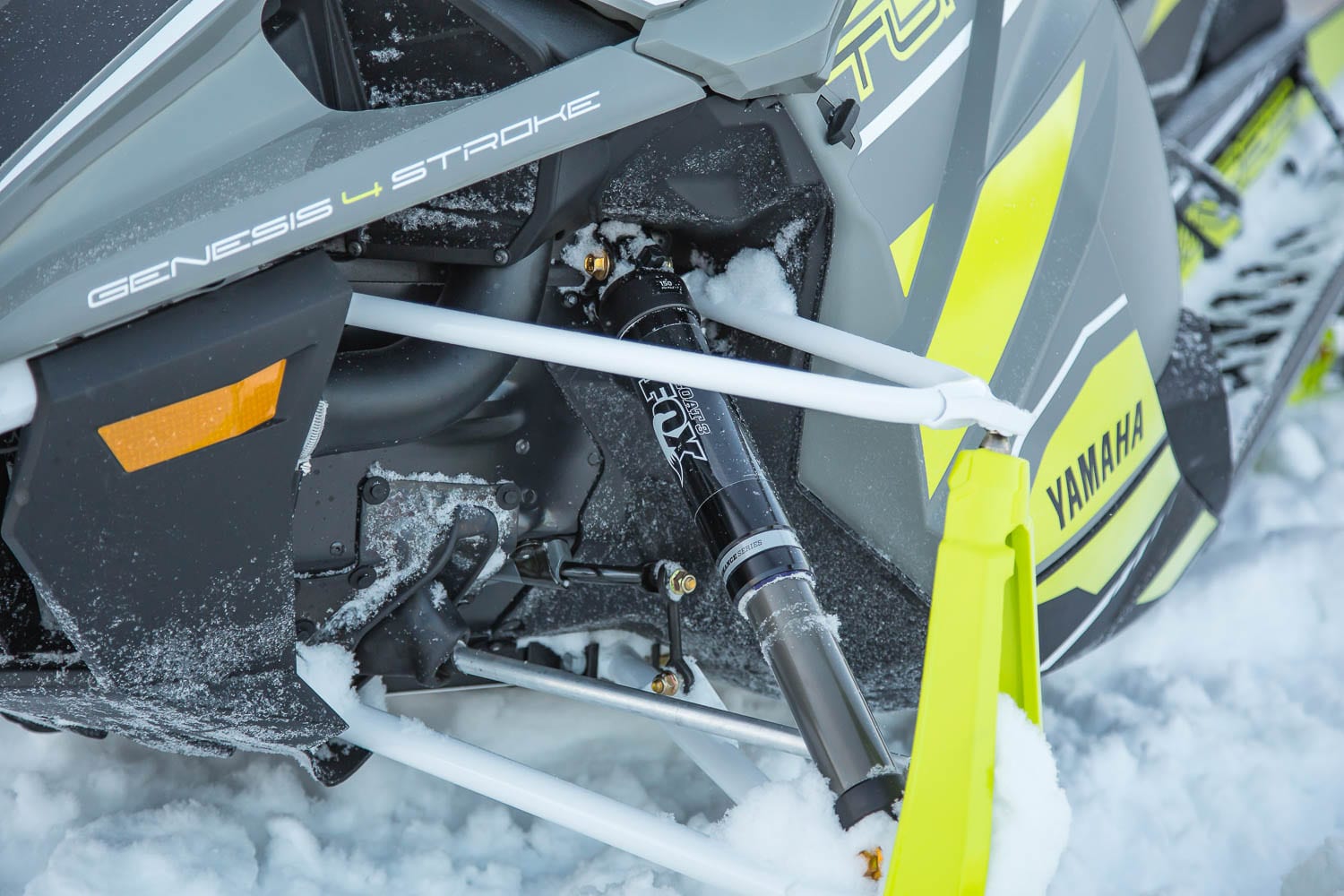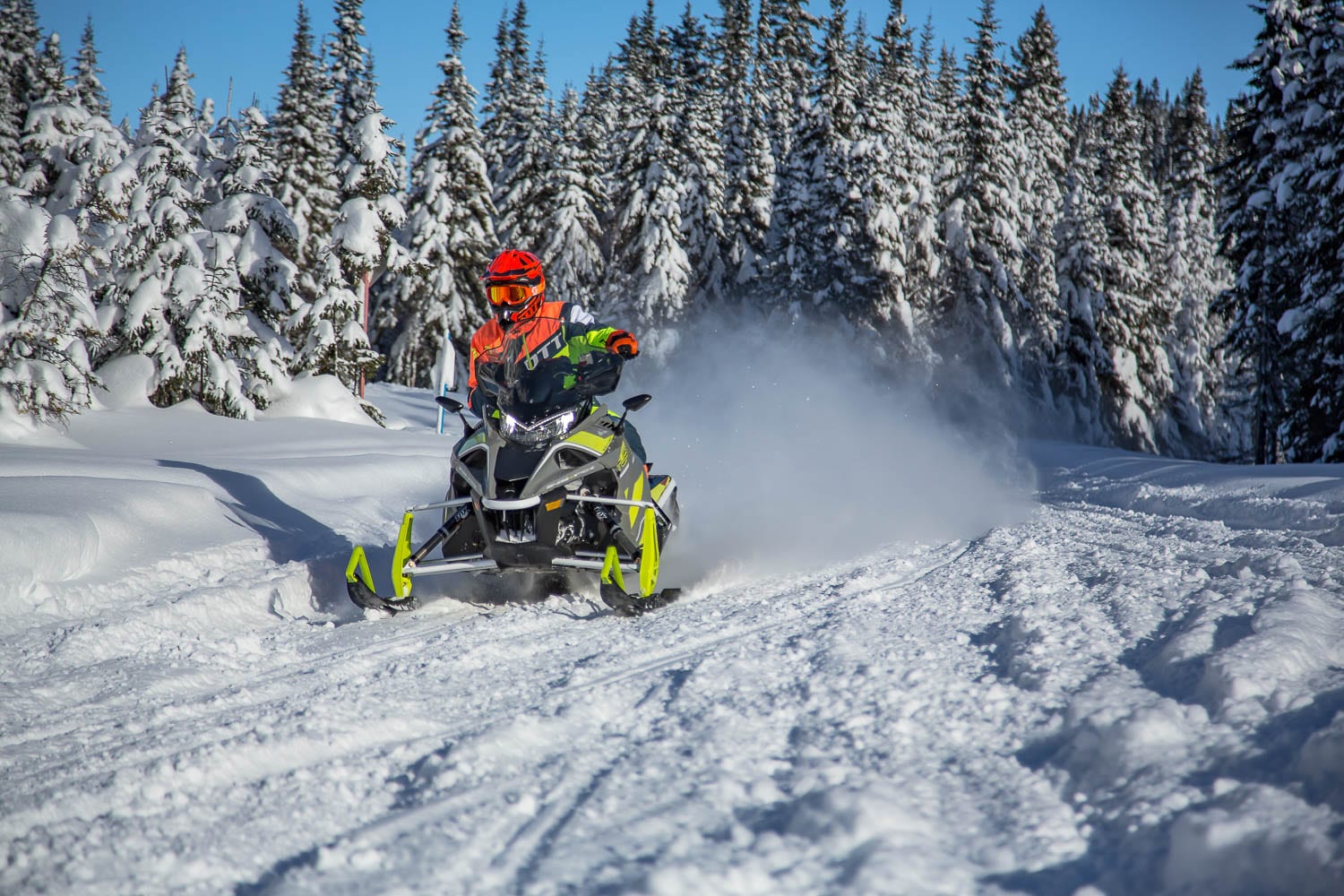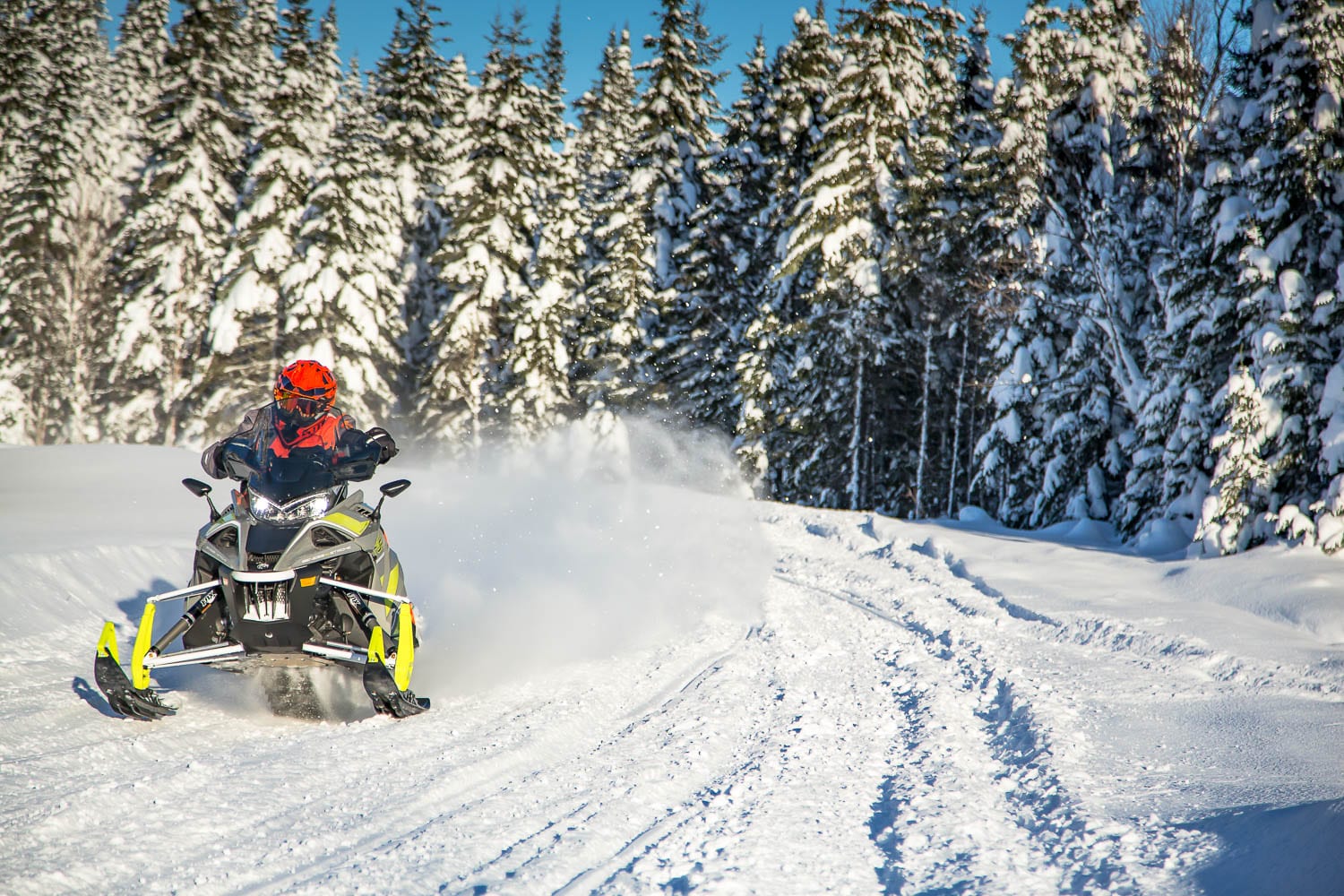A performance hybrid snowmobile? Everyone agrees that a Sidewinder has no shortage of horsepower, no matter what segment it’s in… Today, we’re introducing the 2018 Sidewinder X-TX SE 141, categorized as a hybrid snowmobile. It’s always hard to categorize snowmobiles these days: is it a trail snowmobile or an off-road trail mix? The X-TX has certain characteristics that allow it to manage in deep snow and remain agile on the trail; we could mention here a ratio of 70% trail 30% powder. Its playgrounds: groomed trails, snowy lakes, open terrain and the backcountry.
Crossover Features
The X-TX 141’s off-road heritage is essentially limited to the rear suspension and track. Essential in deep snow, you need traction. The folks at Yamaha went with a Cobra track that was 1.6 inches of heel by 15 inches wide and 141 inches long. Today, to go off-roading, that’s a minimum, this type of track allows for some fun escapades. However, you will lack traction when pushing the note on terrains that are more reserved for the more extreme long tracks.
To help with flotation, there is the Dual Shock SR 141 rear suspension. This suspension is uncoupled (without a transfer adjustment block), which means it allows full rear travel without influencing the travel of the center section. By always keeping full travel in the center of the snowmobile, this makes it easier to climb steep slopes, and easier to climb on snow, an essential characteristic of a suspension designed for deep snow. The Dual Shock has no torsion springs, and a Fox Float 3 air shock provides the suspension pre-load. Simple, light and with almost infinite adjustment. In the center is a 1.5-inch aluminum single-tube high-pressure gas shock. Its sleek design facilitates snow evacuation and reduces unwanted excess weight.
Under the hood
Introduced last year, this three-cylinder, four-stroke, turbocharged engine is simply impressive… Although the technical power figure quoted by Yamaha is 180 horsepower, the Japanese thoroughbred rocked the dyno over two hundred at every opportunity. But the trick with a turbocharged engine was to reduce the response time that is normally very present with a supercharged engine. In order to achieve such good results, the engineers played on two very important aspects: the intake and the blow-off valve. To improve throttle response, the engineers went with three intake throttles, located very close to the intake valves. This facilitates air intake, and improves response. The second aspect was a big issue, when you release the throttle on a turbo engine, the pressure increases very quickly between the turbo and the throttle valves, it is essential to have a valve that releases the pressure. On a traditional engine, this pressure was discharged outside the intake system. To reduce the response time, this pressure is returned through a pipe in the intake just before the turbo, against the rotor on the intake side, so, as soon as the throttles are reopened, the turbo picks up speed more quickly to boost the engine.
The turbo
Le carter des deux turbines est en alliage de nickel, cela lui confère une bonne robustesse et surtout une grande résistance aux très hautes températures. Les roulements à billes sont en céramique, et les pales des deux turbines sont en Inconel, légèreté pour améliorer la vitesse de rotation et résistance pour la fiabilité !
Front Suspension
To keep the weight down, the X-TX’s independent double-wishbone front suspension features Fox Float 3 air shocks with nearly infinite preload adjustment. The steering is handled by third-generation Tuner dual-keel trail skis.
In the field
Although our testing was quite limited, we still had the opportunity to test the X-TX in several conditions. A bit of off-roading combined with several kilometers of trails made up our playground. If we look at the ergonomics, the riding position is without reproach, in a relaxed trail position, the knees are at 90 degrees with enough space in the footrests to facilitate movement. Left-right shifts in aggressive riding are easy, but for a hybrid snowmobile, a slightly higher handlebar riser would make the job easier when standing up. As for the handlebar controls, the high and low beams are easy to use and well positioned. It is the same for the controls of the heated handles and thumb, easily usable with gloves, on the other hand, only two grades of intensity, a greater range of adjustment would be appropriate. The only drawback is the button to control the recoil, which is difficult to access with gloves, a modification should be considered …
During our test days on the Monts-Valin, trail conditions were relatively soft with little grip, which was interesting for a hybrid. A 141-inch track with 1.6-inch studs does well in these conditions. In the corners, despite its longer track, the snowmobile reacted well, a little understeer, but nothing more. If we pushed the limit a little more on the trail, the uncoupled rear suspension allows more weight transfer, which lets the skis fall off the ground during acceleration. When exiting a turn, you have to be more conservative if you want to keep the snowmobile in its trajectory. As for comfort, you have to make some adjustments to find the right compromise, the air shocks are very progressive, some tests have to be done to match the comfort to the driving.
Performance-wise, it’s without reproach, the 180 horsepower are well exploited. The clutches don’t slip and reflect the linearity of the three-cylinder turbo. Starts and accelerations are smooth and don’t give an impression of performance. However, keep an eye on the odometer… Curves come quickly! The engine is very quiet and vibration-free, which doesn’t help to perceive the real speed…
Although our off-trail escapades were short, it is easy to affirm that the X-TX is much more at ease on the trail, the 42-inch ski spread, added to the weight of the big three cylinders, make it more capricious in deep snow, but we can count on the performance of the engine that gives a lot of rotation speed to the track giving respectable results despite a modest track for this type of terrain. This confirms our prediction of about 30% off-trail and 70% on-trail.
In closing, a special thanks to François Morneau of Yamaha Canada who made this test possible.


